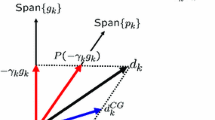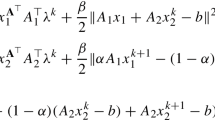Abstract
Bi-quadratic programming (Bi-QP for short) was studied systematically in Ling et al. (SIAM J. Optim. 20:1286–1320, 2009) due to its various applications in engineering as well as optimization. Several approximation methods were given in the same paper since it is NP-hard. In this paper, we introduce a quadratic SDP relaxation of Bi-QP and discuss the approximation ratio of the method. In particular, by exploiting the favorite structure of the quadratic SDP relaxation, we propose an alternating direction method for solving such a problem and show that the method is globally convergent without any assumption. Some preliminary numerical results are reported which show the effectiveness of the method proposed in this paper.
Similar content being viewed by others
References
Bomze, I.M., Ling, C, Qi, L., Zhang, X.: Standard bi-quadratic optimization problems and unconstrained polynomial reformulations. http://www.optimization-online.org/DB_HTML/2009/08/2369.html (2009)
Bonnans J.F., Shapiro A.: Perturbation Analysis of Optimization Problems. Springer, New York (2000)
Cardoso J.F.: High-order contrasts for independent component analysis. Neural Comput. 11, 157–192 (1999)
Chen G., Teboulle M.: A proximal-based decomposition method for convex minimization problems. Math. Program. 64, 81–101 (1994)
Comon P.: Independent component analysis, a new concept?. Signal Process. 36, 287–314 (1994)
Eckstein J., Bertsekas D.P.: On the Douglas-Rachford splitting method and the proximal point algorithm for maximal monotone operators. Math. Program. 55, 293–316 (1992)
Gabay D., Mercier B.: A dual algorithm for the solution of nonlinear variational problems via finite element approximations. Comput. Math. Appl. 2, 17–40 (1976)
Grigorascu V.S., Regalia P.A.: Tensor displacement structures and polyspectral matching. In: Kailath, T., Sayed, A.H. (eds) Fast Reliable Algorithms for Structured Matrices, SIAM, Philadelphia (1999)
Han D., Dai H.H., Qi L.: Conditions for strong ellipticity of anisotropic elastic materials. J. Elast. 97, 1–13 (2009)
He B.S., Liao L.Z., Han D.R., Yang H.: A new inexact Alternating directions method for monotone variational inequalities. Math. Program. 92, 103–118 (2002)
He S., Li Z., Zhang S.: Approximation algorithms for homogeneous polynomial optimization with quadratic constraints. Math. Program. 125, 353–383 (2010)
Kontogiorgis S., Meyer R.R.: A variable-penalty alternating directions method for convex optimization. Math. Program. 83, 29–53 (1998)
Kofidis E., Regalia P.A.: On the best rank-1 approximation of higher-order supersymmetric tensors. SIAM J. Matrix Anal. Appl. 23, 863–884 (2002)
Ling C., Nie J.W., Qi L., Ye Y.: Bi-quadratic optimization over unit spheres and semidefinite programming relaxations. SIAM J. Optim. 20, 1286–1310 (2009)
Luo Z-Q., Zhang S.: A semidefinite relaxation scheme for multivariate quartic polynomial optimization with quadratic constraints. SIAM J. Optim. 20, 1716–1736 (2010)
Pardalos P.M., Ramana M.: Semidefinite programming. In: Terlaky, T. (ed.) Interior Point methods of Mathematical Programming, pp. 369–398. Kluwer Academic Publishers, Dordrecht, The Netherlands (1996)
Pardalos, P.M., Wolkowicz, H. (eds): Topics in Semidefinite and Interior-Point Methods, Fields Institute Communications Series, vol. 18. American Mathematical Society, Providence, RI (1998)
Nikias C.L., Petropulu A.P.: Higher-Order Spectra Analysis, A Nonlinear Signal Processing Framework. Prentice-Hall, Englewood Cliffs, NJ (1993)
Qi L., Dai H.H., Han D.: Conditions for strong ellipticity. Front. Math. China. 4, 349–364 (2009)
Shapiro A., Sun J.: Some Properties of the Augmented Lagrangian in Cone Constrained Optimization. Math. Oper. Res. 29, 479–491 (2004)
Sturm J.F., Zhang S.: On cones of nonnegative quadratic functions. Math. Oper. Res. 28, 246–267 (2003)
Shor N.Z.: Nondifferentiable Optimization and Polynomial Problems. Kluwer Academic Publishers, Dordrecht, The Netherlands (1998)
Sturm J.: Using SeDuMi 1.02, a Matlab toolbox for optimization over symmetric cones. Optim. Methods Softw. 11(12), 625–653 (1999)
Sun J., Zhang S.: A modified alternating direction method for convex quadratically constrained quadratic semidefinite programs. Eur. J. Oper. Res. 207, 1210–1220 (2010)
Thomson W.: Elements of a mathematical theory of elasticity. Philos. Trans. R. Soc. 166, 481 (1856)
Thomson W.: Elasticity, Encyclopedia Briannica, 9th edn., vol. 7. Adam and Charles Black, London (1878)
Zhang T., Golub G.H.: Rank-one approximation of higher-order tensors. SIAM J. Matrix Anal. Appl. 23, 534–550 (2001)
Zhang, X., Ling, C., Qi, L.: Semidefinite relaxation bounds for bi-quadratic optimization problems with quadratic constraints. J. Global Optim. (2010). doi:10.1007/s10898-010-9545-5
Yu Z.S.: Solving semidefinite programming problems via alternating direction methods. J. Comput. Appl. Math. 193, 437–445 (2006)
Yuan, X.M., Yang, J.F.: Sparse and low-rank matrix decomposition via alternative direction methods, Optimization Online (2009) http://www.optimization-online.org/DB_HTML/2009/11/2447.html
Author information
Authors and Affiliations
Corresponding author
Additional information
This work is partially supported by the National Natural Science Foundation of China (Grant No. 10871144).
Rights and permissions
About this article
Cite this article
Hu, SL., Huang, ZH. Alternating direction method for bi-quadratic programming. J Glob Optim 51, 429–446 (2011). https://doi.org/10.1007/s10898-010-9635-4
Received:
Accepted:
Published:
Issue Date:
DOI: https://doi.org/10.1007/s10898-010-9635-4




